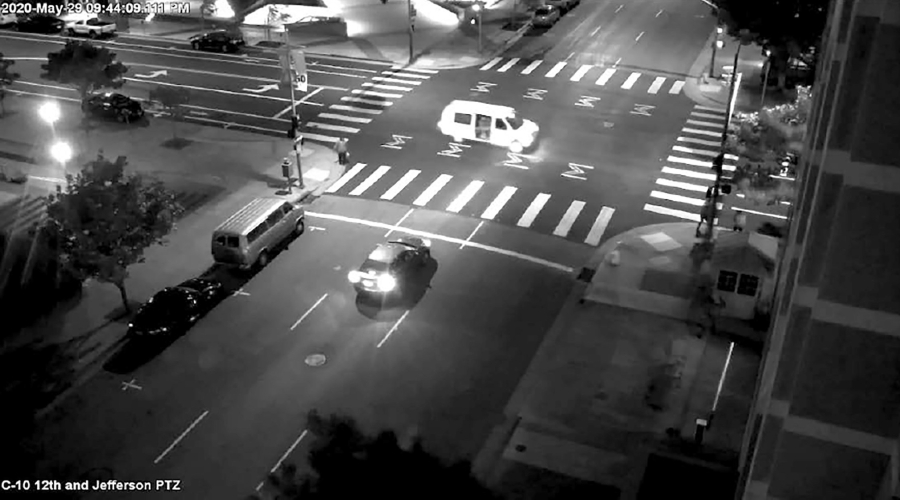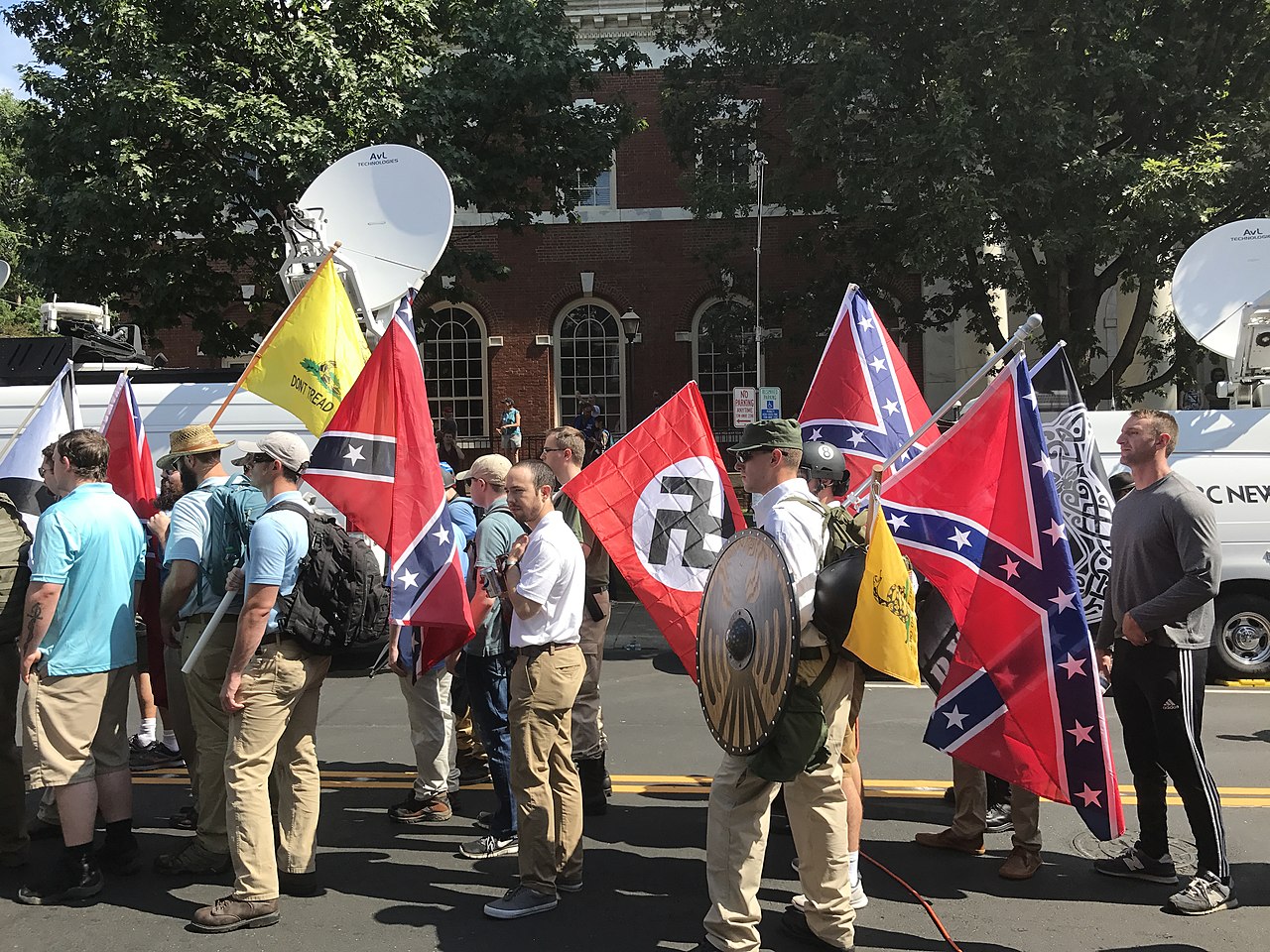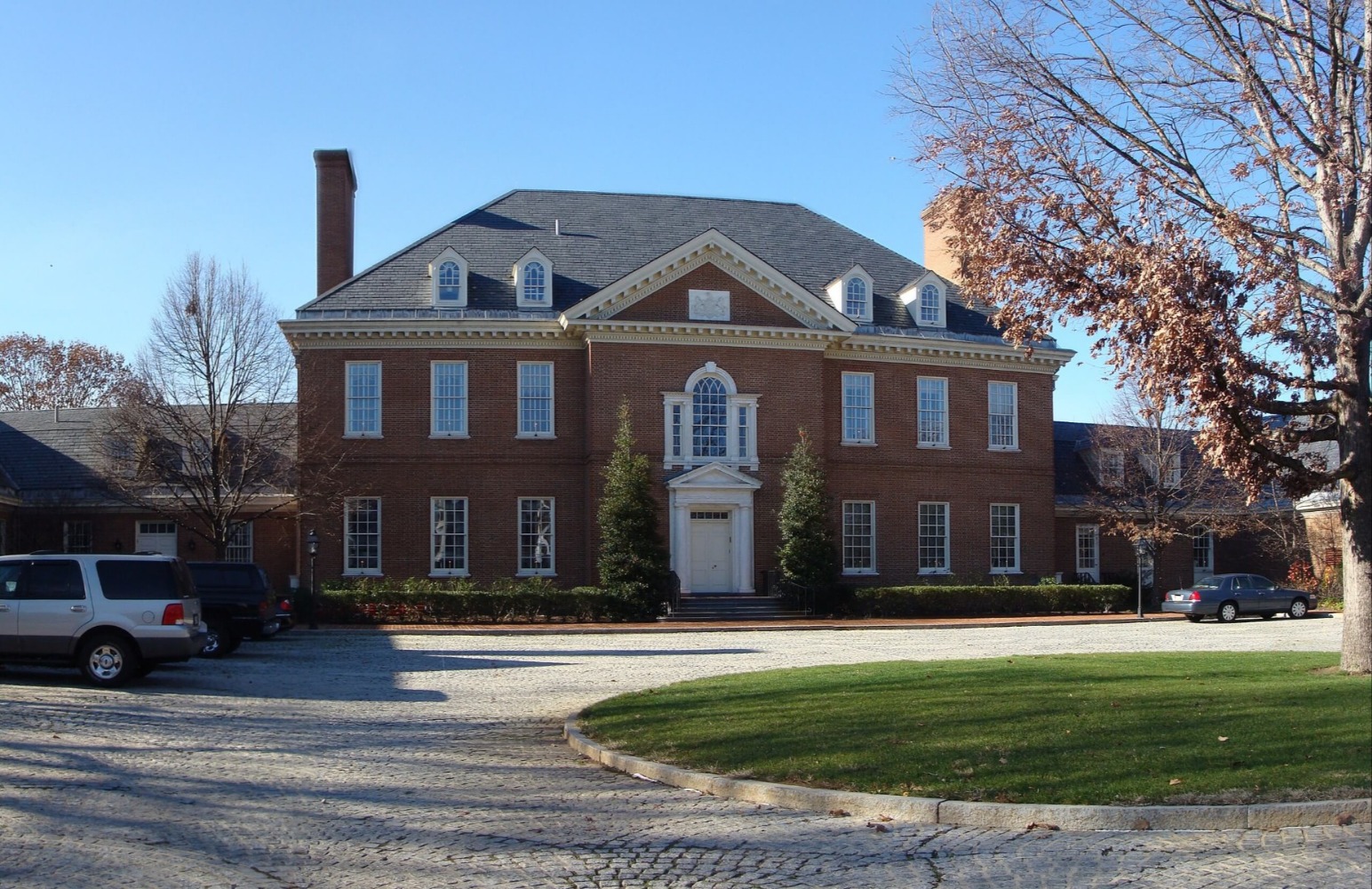Rethinking Domestic Terrorism Law After Boogaloo Movement Attacks
The U.S. legal framework for foreign terrorism should be adapted to the domestic context.

Published by The Lawfare Institute
in Cooperation With

On May 29, two contracted Federal Protective Service officers were shot outside the Ronald V. Dellums Federal Building and U.S. Courthouse in Oakland, California. Several days later, the alleged perpetrator, Steven Carrillo reportedly shot two sheriff’s deputies who were investigating the van that was used in the initial attack. Before Carrillo was finally detained by law enforcement, he carjacked a vehicle and used his own blood from a gunshot wound to write several phrases, including “Boog,” on the hood of the vehicle. The day after the shooting, Department of Homeland Security Acting Secretary Ken Cuccinelli claimed that “[w]hen someone targets a police officer or a police station with an intention to do harm and intimidate—that is an act of domestic terrorism.”
Steven Carrillo was ultimately charged with the murder and attempted murder of the two Protective Service officers, while his co-conspirator who reportedly drove the van, Robert Justus, was charged with aiding and abetting these actions. The criminal complaint alleges that Facebook records provided to the government show that Carrillo, Justus, and others were “discussing a plan to travel to Oakland and attack federal law enforcement officers.” The government alleges that, following this discussion, Carrillo and Justus drove a van to the federal courthouse and “opened fire on two guards with an assault rifle.” After Carrillo’s arrest, law enforcement recovered a privately made AR-15-style rifle that had been modified to fire two- or three-round bursts and fitted with a silencer, and confirmed through ballistic analysis that the recovered weapon had fired casings that were recovered from the Oakland crime scene.
This violence, and the numerous incidents of disrupted plots from those aligned with the “boogaloo” movement, has sparked an increase in media coverage on every facet of the movement—from the meaning of the word, the contours of the movement, the inspirations and ideologies of its followers, even to their outfit choice of Hawaiian shirts. However, the media fascination with and analytic assessments of the boogaloo movement as a seemingly new and unknown threat risks missing the forest for the trees. The violent plots orchestrated by those who have been identified as “boogaloo bois” are a manifestation of anti-government, right-libertarian ideologies that promote an accelerationist agenda of provoking societal collapse through mass violence. The boogaloo movement itself is not a cohesive or organized movement, nor does it adhere to a unified ideology or set of guiding principles. Even the term “boogaloo” itself—an internet meme that has come to represent calls to engage in violence in the hopes of sparking what adherents believe is an impending civil war—continues to be seized upon by a diverse range of actors who seek to perpetrate deadly acts of domestic terrorism. This “movement” should be viewed candidly and as simply window dressing for the well-organized and pervasive threat posed by the various strands of white supremacist, neo-Nazi and anti-government movements. The threat they pose should prompt long overdue legal reforms to U.S. domestic terrorism statutes to allow more effective investigations and prosecutions of their actions.
Crucially, these actors and ideologies have long taken advantage of missteps and inaction by social media companies, the federal government, and even the U.S. military to develop a complex ecosystem that continues to operate freely within the United States. Along with the broader militia ecosystem in the United States, these movements have enjoyed years of relative freedom online and offline to recruit, fundraise, and radicalize their supporters to violence. Recent instances of violence motivated by these ideologies—such as the mass casualty acts of domestic terrorism in Oklahoma City, El Paso, Charleston and Pittsburgh—have showcased the failures of the executive and legislative branches to elicit effective long-term policy solutions that properly prioritize, recognize and combat the root causes of domestic terrorism in the United States.
The need to recognize the true nature of this broader threat has become paramount as the increased prevalence of online incitement by these movements appears to have led to attempted acts of real-world violence in recent weeks. In addition to the targeting of law enforcement officers in Oakland, numerous individuals self-affiliated with the boogaloo movement have been arrested prior to engaging in acts of violence. In Nevada, three individuals face state terrorism charges after being arrested in Las Vegas while attending a protest. They were in possession of Molotov cocktails and allegedly intended to incite violence and chaos. The group had reportedly planned to target power substations or ranger stations with explosives and discussed the need to “violently overthrow the United States government.” In Denver, Bradley Bunn, who reportedly posted a manifesto calling for “armed defiance against tyrants,” was arrested for possession of four pipe bombs. In Oklahoma, Christopher Ledbetter, who was charged with and pleaded guilty to unlawful possession of a fully automatic machine gun, was alleged to have openly discussed “hunting cops” and his belief that “police were the equivalent of terrorists.” In Texas, Aaron Swenson was arrested and indicted on state charges for attempted capital murder of a peace officer after reportedly broadcasting his hunt for a police officer on Facebook Live.
This recent spike in extremist activity related to the boogaloo movement has not gone unnoticed by policymakers. Congress has pressured law enforcement agencies and social media companies following recent incidents targeting law enforcement and U.S. infrastructure perpetrated by individuals with links to the boogaloo movement. Rep. Max Rose, chairman of the House Subcommittee on Intelligence & Counterterrorism, sent a letter to the Department of Homeland Security requesting “an assessment specifically on this movement and any potential violent threats that they may pose.” And, on July 16, the subcommittee held a virtual hearing titled “Assessing the Threat From Accelerationists and Militia Extremists,” with Rose’s opening statement noting that “[t]he Boogaloo movement has been thrust into the spotlight in recent months as we have seen attack after attack, arrest after arrest, of men affiliated with the Boogaloo movement.” However, to date, Congress has not taken substantive legislative action to facilitate better confronting this threat. One important step would be to revise how the U.S. legal system prosecutes domestic terrorism.
Notably, none of the perpetrators identified as being affiliated with the boogaloo movement who have plotted, attempted to, or successfully engaged in these acts of domestic terrorism were charged with violating federal terrorism statutes. This is because the U.S. Code does not create a specific charge of domestic terrorism; rather, the “terrorism” label is applied only in statutes describing specific crimes that transcend national boundaries or involve the provision of material support to terrorists or a foreign terrorist organization. As has been argued previously, the current definitional framework for a “federal crime of terrorism” includes myriad predicate offenses, but these offenses are rarely evidenced in the current realm of terrorist tactics and would not include, for example, an ideologically or racially motivated mass shooting or vehicle ramming of civilians. In the recent cases of boogaloo-linked activity, only the alleged murder of a federal officer in violation of 18 U.S.C. § 1114 is considered a predicate offense under the existing definitional framework. In this case, given the steep potential criminal penalties already associated with this charge, the practical consequences of labeling this an act of domestic terrorism would likely be confined to an enterprise investigation into Carrillo and any potential network.
This gap in our existing terrorism statutes should be filled by a robust, rights-protecting domestic terrorism statute that would allow for the prosecution of individuals on terrorism charges that reflect the totality of their conduct in furtherance of acts of domestic terrorism. As experts have argued, this statute could be based on the existing transnational terrorism statute, 18 U.S.C. § 2332b, creating a new law criminalizing the same acts—with the absence of property damage—when they take place within the United States. When subsequently added to the list of 18 U.S.C. §2339A predicate offenses for material support, this could allow law enforcement to better marshal resources and interagency cooperation, interdict plots, and help ensure appropriate charges and penalties with respect to the prosecution of domestic terrorists in the United States.
Critics of a domestic terrorism statute rightfully highlight the risks of federal overreach and potential for civil rights violations. While these concerns should not be used to justify further legislative and executive inaction, any statute of this kind must be narrowly focused and based on the rule of law. It should limit any new criminal statutes to acts of violence against persons—such as homicide and assault under 18 U.S.C. § 2332b—and provision of material support to terrorists under 18 U.S.C. § 2339A. It must also be subject to strong oversight by Congress and its watchdog, the Government Accountability Office, as well as through processes such as biannual audits by the Office of the Inspector General. Furthermore, oversight efforts by independent agencies such as the Privacy and Civil Liberties Oversight Board are imperative in order to help prevent civil rights abuses.
The boogaloo movement is far from a singular, homogeneous group. Even if this were the case, designating domestic groups using similar legal mechanisms, as we do for foreign terrorist organizations, is not only constitutionally problematic but also likely ineffective and characteristic of a misunderstanding of modern-day domestic terrorism. As evidenced by the recent law enforcement operations against both Atomwaffen and The Base, the new wave of domestic terrorism is strikingly similar to historical patterns of leaderless resistance. Small, disorganized, and loosely affiliated cells of domestic terrorists that may possess transnational links, but seemingly lack formal connections to foreign white supremacist terrorist organizations, will continue to pose a unique challenge to law enforcement. The threat posed by other foreign state and non-state actors who seek to undermine democratic values, sow discord, and support domestic terrorists will require a host of pragmatic policy solutions. Unlike a narrow domestic terrorism statute in which individuals would be prosecuted for their actions in furtherance of committing violence rather than an ideology, attempting sweeping designations of domestic groups is not the targeted or nuanced solution required to effectively combat this dynamic threat.
Despite the recent fascination with the boogaloo movement, which has captured the attention of policymakers and the media alike, this ideological violence should be viewed as merely the latest incarnation of accelerationism in the United States. The challenges of domestic terrorism have long posed intractable problems for the federal government’s counterterrorism and law enforcement apparatuses, which have failed to properly reorient and respond in a proportional manner. Efforts to adequately counter and prosecute those who attempt to engage in real-world violence in furtherance of domestic terrorist causes must reflect the totality of their actions. Until then, we will remain a step behind those who seek to commit acts of hate in the homeland.





